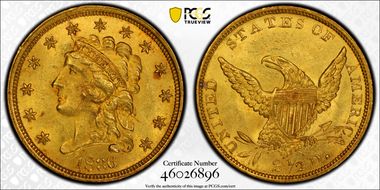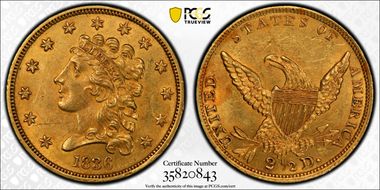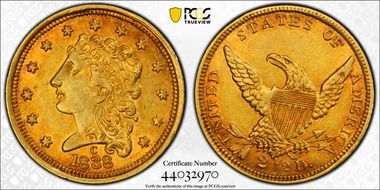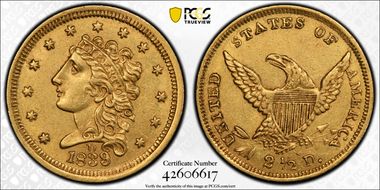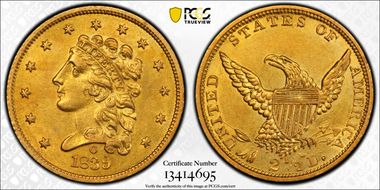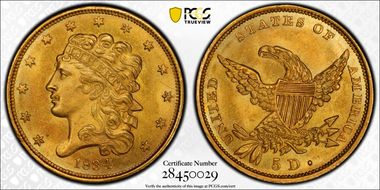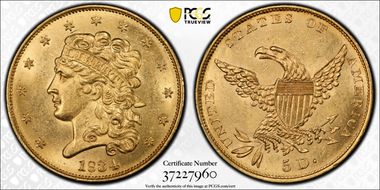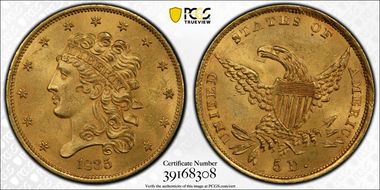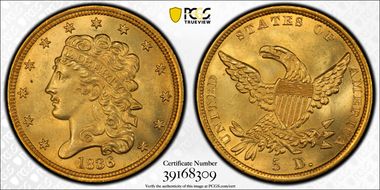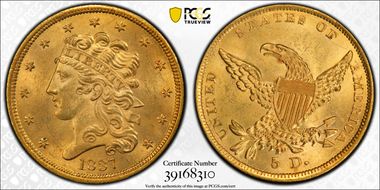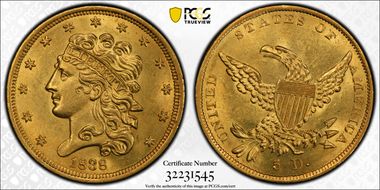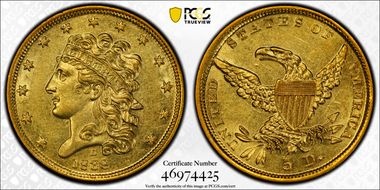The Oak Collection 的钱币相册
OGH/CAC, HM-2, R-3. Obverse 2: Large indent in hair at bottom of the portrait. Reverse B: Widely spaced A M in AMERICA; split berry. This example has vivid golden-olive surfaces which are further enlivened by intense luster in a satin to semi-reflective finish. It is extremely well struck without the weakness of IBE in the hairband that is frequently seen on this variety. There is a “floating serif” in the right reverse field that appears to have come from the T in UNITED. A very interesting coin! PCGS Gen 3.0 Holder. Stack’s Bowers 3/23: 7015.
HM-1, R-4. Obverse 1 (unique) and Reverse F which is the same as 1836 HM-1 and HM-8 and 1837 HM-2; there is only one die pairing in 1839. This is a rare mint state example. The green-gold color is accented by light orange toning toward the periphery on the obverse. The strike is strong with any weakness consistent with other high-grade examples. There are minor reeding marks on the obverse portrait. Purchased from Crescent City Numismatics.
CAC/OGH, HM-7, R-3. Obverse 5 is the same die as HM-6. Reverse G is the same die as HM-4. This is the most common 1836 die marriage. The swirling cartwheel luster is exceptional. This orange-gold example has a strong strike except for weakness in stars five and six, a characteristic for this die pairing. GreatCollections 10/20: 885891.
CAC, HM -1, R-3. Obverse 1, Reverse R: There is only one die pair known for the 1838-D half eagle; both the obverse and reverse are unique dies. The half eagle was the first denomination produced at the Dahlonega Mint. This crusty, original coin has appreciable dirt clinging to the devices on both obverse and reverse. It has rich honey-orange and medium rose colors; the surfaces retain appreciable satin luster that is brightest in the protected areas around and among the design elements. It is well struck in general and mostly sharp and is free of troublesome marks with a pleasingly smooth appearance in hand. Stack’s Bowers 8/24: 3324; ex: Heritage 8/14: 5651.
CAC, HM-1, R-2. Obverse 1: Nearly straight roll of curls at back of head; this obverse die is unique. Reverse A: Solid berry, 3rd Arrowhead touches middle of the right base of A. This is the most common die pair in 1834 representing more than 50% of the examples found. This example displays sharply detailed design elements, with full radials on all star centers. The lightly marked orange-gold surfaces have patches of red-orange toning. The luster exhibits a mix of satiny mint luster and prooflike reflectivity in the fields. The reverse die was rotated about 30% when this coin was struck. Purchased from Crescent City Numismatics.
CAC, HM-2, R-3. Obverse 1: The Mint used a single obverse die to strike all 1835 quarter eagles. Reverse B: Widely spaced A M in AMERICA split berry; the same as 1834 HM-2. This is the most common pairing in 1835 representing over 85% of the assumed survivors. As with all 1835 Quarter Eagles, the central devices are weakly struck but this example has better definition than most. The color is green-gold and the surfaces are prooklike. A beautiful example of this date. Purchased from Crescent City Numismatics.
CAC, HM-4, Script 8, “intermediate/late” die state, R-1. Obverse 4: Script 8; Curved Profile; Star 6 points to lowest portion of first hair curl; 8 IS LOW AND 3 IS EVEN LOWER IN DATE. Reverse E is the same as HM-3 and 1835 HM-3 and is the only reverse in 1836 with no berry. Well struck despite the deteriorating condition of the obverse die. The luster is muted, and the color is orange-gold with scattered hints of cherry-red. The obverse has a bisecting die crack which runs from the left of star 6 through Liberty and the field between stars 12 and 13. This crack is met above the ear with a crack to the lower jaw. The reverse does not have the “normal” crack from the left wing to through the lower base of S but does have a shallow crack from the top left of the shield to the Eagle’s beak. Heritage 12/22: 3581.
CAC, HM-1, Block 8, R-3. Obverse 1: Curved profile and large indent in hair at bottom of portrait; this obverse die is unique. Reverse F: VERY weak detached tongue; 3rd Arrowhead under right base of A. This example is green-gold with orange-gold toning and pleasing cartwheel luster. The strike is very strong except for some minor weakness on the hair below the Liberty Band.
HM-1, R-3, Bass-Haynor. Obverse 1: Star 8 points to the left side of the third curl on the top of Liberty's head; Bulbous lower lip and open mouth. Reverse A is the same as 1834 HM-1. This is the finest known 1837 Quarter Eagle. Boldly to sharply rendered throughout, this coin exhibits superior definition for a circulation strike quarter eagle of the type. Beautiful satin surfaces exhibit a few blushes of faint powder blue iridescence on dominant golden-orange color. There is a faint die crack from the top of the 8 into Miss Liberty’s hair. New York Gold Mart; ex: Stack’s Bowers 8/2022: 5015 (Daryl Haynor’s The Virginian Collection); ex: Harry W. Bass, Jr. Collection, Part II, October 1999, lot 305.
CAC, HM-1, R-3. Obverse 1 (unique) and Reverse H which is the same as 1837 HM-3; there is only one die pairing in 1838. Beautiful frosty luster adorns green gold surfaces. The strike is extremely strong and there are no significant contact marks. The obverse has a wide rim and small denticles. It would be a pleasure if all coins were graded this conservatively. Purchased from Crescent City Numismatics.
CAC, HM-1, R-4. There is a single die pair known. The obverse is unique; the reverse was subsequently used for 1839-C HM-1; there is only one die pairing in 1838-C. Virtually Mint State, this impressive piece has a trace of rub on the high points with minuscule handling marks. Both sides display lustrous green-gold surfaces with gorgeous peripheral rose toning. Although not clearly visible on the PCGS image, there is a distinct die crack from the left shield through the eagle’s lower beak. This crack may have led to the soft strike at the juncture of the shield and the eagle’s left wing. Heritage 9/23: 3101,
CAC, HM-1, R-4. Obverse 1 (unique) and Reverse F which is the same as 1836 HM-1 and HM-8 and 1837 HM-2; there is only one die pairing in 1839. This is an exceptional example with “dirt” clinging to several devices and green gold color dramatically accented by red orange toning. The strike is strong with any weakness consistent with other high grade examples. Heritage 1/22: 3894 (as an NGC AU58).
CAC, HM-3, R-4+. Obverse 2: The C is over the left side of the 3. Reverse K: The rounded branch tip extends to the left serif of the D, the 1 in ½ is far from the bar and the TES in STATES are close; this reverse die is unique. This is the second year of production of Classic Head Quarter Eagles at the Charlotte mint. The year featured three die pairings; the HM-3 is the second rarest of the three. On this example, the strike is good for the issue. It has a satin luster, and the color is orange gold with vibrant red-orange toning. On the obverse, there is a “strike through” on the face that is typical for obverse 2. On the reverse, there is a large die crack through the E in STATES into the field above the eagle. Purchased from Doug Winter in his sale of the MARK GHIORSO collection.
HM-3, R-4+. Obverse 2: The C is over the left side of the 3. Reverse K: The rounded branch tip extends to the left serif of the D and the 1 in ½ is far from the bar; this reverse die is unique. This is the second year of production of Classic Head Quarter Eagles at the Charlotte mint. The year featured three die pairings; the HM-3 is the second rarest of the three. On this example, the strike is strong for the issue, has a satin texture, and the color is orange-gold. On the obverse, there is a “strike through” on the face that is typical for obverse 2; this characteristic has been given the nickname “bandit face”. On the reverse, there is a large die crack through the E in STATES into the field above the eagle.
CAC, HM-2, R-4. In 1839, the Dahlonega mint had a single year of production for Classic Head Quarter Eagles. It is the only year where the mint mark was on the obverse. The year had one obverse and two reverses. The reverse is identified by no berry, and a weak branch stem approaching the upright of D in the denomination. This green-gold representative shows striking weakness on the middle letters in LIBERTY. Noticeable frosty luster remains. Purchased from Heritage; ex: SB 11/21: 4091.
CAC, HM-1, R-3. This die marriage represented the first gold coins struck at the New Orleans mint. This variety has the traditional layout with a coin turn unlike the HM-2 which has a “medal turn”; it has a high date on the obverse and a wide fraction on the reverse. The obverse indicates a late die state because die polishing has fragmented the curls by the Y in LIBERTY. The reverse has several die cracks near UNITED but does not have the die cracks near STATE OF that would indicate a really late die state. Sharply struck devices show a glowing frosty luster that blooms around the protected areas. Rich green-gold color enhances high-quality fields. Purchased from Crescent City Numismatics.
HM-1 (Late die state), R-3. Obverse 1: High Date with the 3 lower than other digits; this obverse die is unique. Reverse N: Wide fraction, no berry and a weak branch stem; the reverse die is unique. This die pairing represented the first gold coins struck at the New Orleans mint. This variety has the traditional layout with a coin turn unlike the HM-2 which has a “medal turn”. The surfaces are green gold with frosty luster. The devices are sharply struck but extensive die polishing shows fragmented curls by the Y in LIBERTY on the obverse and thinning of the leaves, arrow shafts and feathers on the reverse. The reverse has extensive die cracks – one runs from the bottom of T through the bottom of I in UNITED through leaf 1 to the 2 in 2 ½ to the rim. The second runs from the bottom of A to the top of M in AMERICA. Purchased from Stack’s Bowers.
CAC, HM-4, R-5+. Obverse 3: Script 8, the 3 and 4 are distant in the date (same as HM-3). Reverse B: 5 left of arrow, middle arrow shaft missing left of the eagle’s claw (same as HM-2). This is the finest known HM-4, the rarest die pairing in 1834. It is over four times scarcer than the Crosslet 4. On this example, the strike is extremely strong, showing only minor weakness on stars three through five and the BE in the Liberty Band. The luster is frosty, displaying a full cartwheel effect. Brilliant orange and bluish toning are highlighted throughout. The obverse has a die crack running from the eye to the back of the mouth and the reverse has a die crack running along the lower portion of NITED in UNITED. A stunning example of a Classic Head Half Eagle. Purchased from Crescent City Numismatics.
CAC, HM-9, R-4. Obverse 5: Script 8 and the well-known Crosslet 4 in the date; this obverse is unique. Reverse D: There is no tongue, no berry and the 5 is directly below the arrow feather. This example is the first of only two UNC coins verified by CAC for this variety. It has beautiful, original “skin” and is highly reflective with satiny, semi-prooflike luster. The strike is extremely strong for the type; the color is yellow gold. Reverse D exhibits a distinct die clash within the vertical shield stripes. It is the ERT and part of Y from the obverse of 1835 HM-1. 1835 HM-1 was minted prior to the 1834 Crosslet 4. Purchased from Crescent City Numismatics; ex: Bowers and Ruddy 10/77 (Fairfield Collection): 1770.
CAC, HM-8, R-3+. Obverse 3 is the same die as HM-7. Reverse A is the same die as HM-4 and HM-6 in 1835 and HM-1, HM-5, and HM-8 in 1834. Tied for finest known at PCGS (13 MS64) and CAC (3 MS64). This is the third most common 1835 die pairing but there are still only 200 suspected survivors. Two of the MS64 1835 half eagles were stuck from these dies; the current coin and the Pogue-Haynor example which sold in September 2022. This well stuck example is green gold with pleasing cartwheel luster. Though well struck, the reverse die is now showing a great deal of deterioration. There are many die cracks, noticeable along the bottom of many letters and from the wing tips to the rim. The right side of the N in UNITED and the top of the first S in STATES are filled in. Purchased from Crescent City Numismatics.
HM-6, R-3, POGUE. Obverse 5: Double forelock, Tall 1 and high, R in LIBERTY is high. Reverse I: Berry with stem, very wide 5 D, O larger than F. A substantial mintage of 553,147 Classic Head half eagles was produced in 1836, with nine different die varieties known for the date. Smooth satiny luster evenly coats both sides, each a light apricot gold. Devices on obverse and reverse are nicely struck, lending further appeal to the supremely attractive and very frosty surfaces. Purchased from Heritage; ex: Stack’s Bowers 5/16: 4053 (Pogue Collection).
CAC, HM-2, R-3+. Obverse 2: The only obverse of the issue with both a single forelock curl and block 8 in the date: this obverse is unique. Reverse L: The middle arrow shaft is broken within the eagle's talon, the only reverse of the issue with this feature. Reverse L is the same as 1838 HM-1. 1837 had the lowest P-mint mintage in the Classic Head Half Eagle series; the HM-2 die pairing is the most common of the three pairings that year. On this example the striking details are complete throughout. The mint luster is abundant and shows a bright, frosted sheen on orange gold surfaces. There are a few insignificant luster grazes on the obverse and a light alloy spot below the eagle's beak on the reverse. Purchased from Crescent City Numismatics.
CAC, HM-1, R-3. Obverse 1: Tall curved serif on 1, center dot in ear; this obverse is unique. Reverse L is the same die as HM-2 in 1837. Beaming, satiny mint luster blooms with a vivid brilliance on both sides. Boldly struck up on the obverse and reverse, the details are crisp and show impressive frost on the devices. There is a clash mark on the reverse in the eagle’s mouth and below the beak. Legend Auctions 10/20: 378.
HM-1, late die state, R-4+, Haynor. Obverse 1: There is only one obverse die for the ’38-C. Reverse P: Leaves 1 and 2 are far from the U in UNITED; this reverse is unique. The underlying color is green-gold but there is some reddish-russet build up within the protected areas of Liberty's portrait, as well as in isolated peripheral areas on both sides. This is a late die state example of the HM-1 die pairing where extensive die lapping has removed the berry and the connection between the stems of the leaves and the eagle’s leg. Stack’s Bowers 8/2022: 5054 (Daryl Haynor’s The Virginian Collection); ex: Heritage 1/08: 3162.
CAC, HM-2, early die state, R-7. Obverse 1: There is only one obverse die for the ’38-C. Reverse Q: Leaf 2 touches the U in UNITED; this reverse is unique. The 1838-C is the rarest date/mint combination in the Classic Head Half Eagle series and this pairing is the rarer of two distinct pairings. This example is very original with green-gold color and rich orange highlights. The strike shows much sharper detail than normal for this mint. It was minted before the die crack which normally bisects the reverse of this pairing. There are only three or four known examples in this state. This is a truly exceptional example of this very rare type. Purchased from Doug Winter.
HM -1, R-3. Obverse 1, Reverse R: There is only one die pair known for the 1838-D half eagle; both the obverse and reverse are unique dies. The most recent estimate is that only 10-12 examples are known in mint state. The strike on this yellow gold example is exceptional; the only weakness is on the peripheral stars where the radial lines are generally missing; this probably resulted from excessive die polishing. The texture is a subtle frost with prooflike characteristics, particularly on the reverse. There is some die rust evident with raised “bumps” in front of the top of the throat.


























